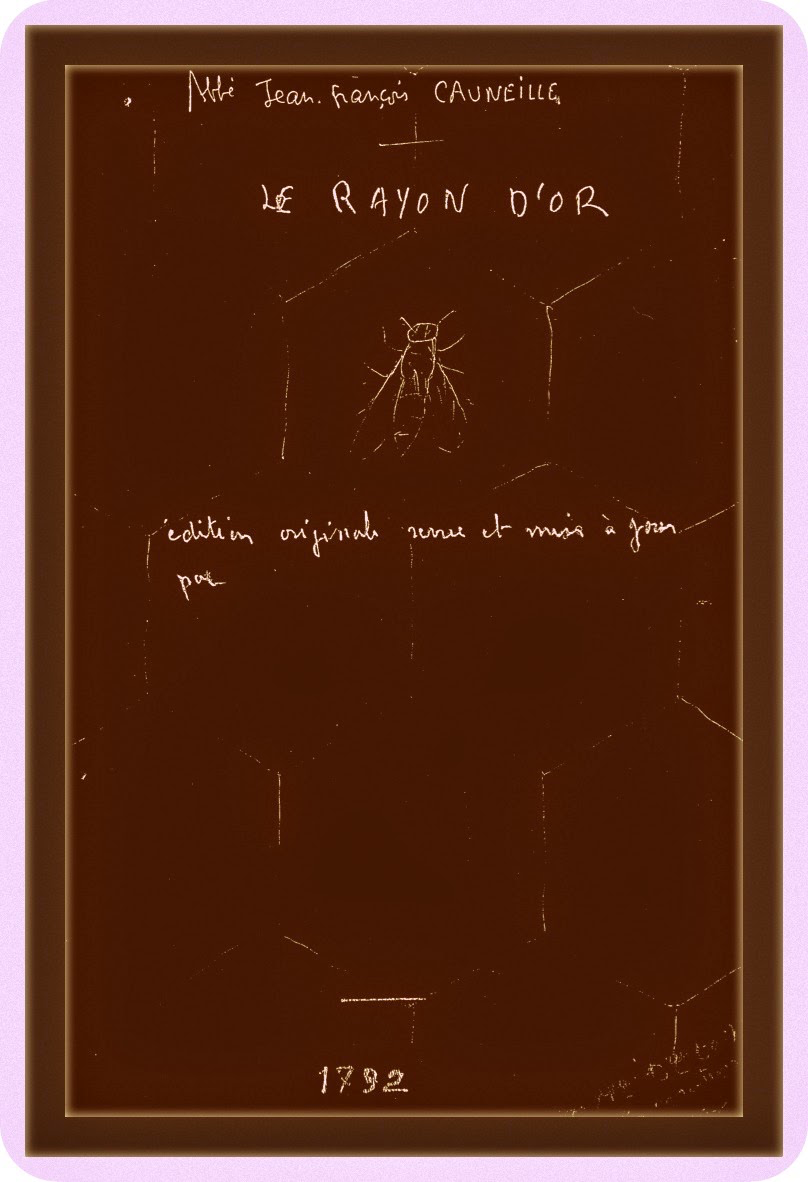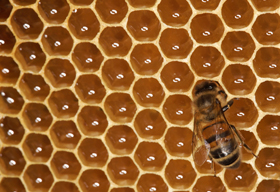LE RAYON D'OR DE L'ABBE CAUNEILLE
Posted below is an image from this site [posted in 2014] - a picture of the cover of the rare and thought to be non-existent book - LE RAYON D'OR DE L'ABBE CAUNEILLE. There is no further information about the provenance of the book etc or how the book was obtained etc. And no further information about its contents. As you can see - the book cover depicts the date of 1792, with an illustration of a bee alighting on a hive in the shape of honeycombs. Lets hope more information will soon be forthcoming ...


Why is it interesting in regard to Rennes-le-Chateau?
Since Gerard de Sede wrote L'Or de Rennes (Ed. Julliard 1967), the role of Father Cauneille in the history of Rennes-le-Château established a timeline as follows:
Abbé Emile Francois Cayron, the parish priest of St Laurent de la Cabrerisse in the Aude allegedly received a "Great Secret" orally from the Abbé Cauneille (who had received it directly from Antoine Bigou). Abbé Cauneille also passed the same ‘secret’ on to Abbé Jean Vié, parish priest of Rennes-les-Bains from 1840 to 1870. Abbé Henri Boudet who succeeded Jean Vié as the parish priest of Rennes-les-Bains was himself from a poor family in Quillan who was educated and formed by the same above mentioned Abbé Cayron.
Father Cauneille was then discussed at greater length in 1971 by Philip de Chérisey in pages 68 and 69 of his typescript Circuit. In 1982, we also find the chain of priests having transmitted said "secret" explained by Jacques Brétigny and Jean-Pierre Deloux on page 32 of their book Rennes-le-Château secret capital of history of France (Ed Atlas). Taking Philip Chérisey at his word, these two authors credited Father Cauneille a hypothetical publication of two books: The Golden Ray and The Line of Sight.
Regarding the idea of priests transmitting the "secret" in this way only after a few elementary checks, it becomes obvious that it does not withstand analysis. Indeed, as already written before, François-Pierre Cauneille died in 1804 from a serious illness while Geraud de Cayron was born in 1807 and Father Jean Vié in 1808 as we learn from his death certificate. Accordingly, neither of the last two could have known the Father Cauneille!
So, what was Chérisey's purpose in drawing our attention to such concepts?
La trace du feu/ the line of Sight refers to - if we keep the mathematical and geometrical concepts in context here - means an intersection of a line or a plane with one of the plans projection. This is descriptive geometry - where Descriptive Geometry is the graphical solution of point, line and plane problems in space. These solutions are accomplished by means of the same principles of orthographics projection which are used in making a 3 view drawing of an object. The Line of Sight is the vector path from the viewer to a particular point on an object. Principal Views (planes) - are any of the six orthogonal image planes defined by the six mutually othogonal LOS.
Put simply the line of sight is a straight line along which an observer observes an object. It is an imaginary line that stretches between observer's eye and the object that he is looking at. Suppose an observer observes an bird on a tower. In the following figure, AB represents a tower and P be the position of a man who is standing on the horizontal ground watching a bird at the top of the tower. So, the line joining the eyes of the man and the bird is called the line of sight. So, PB represents the line of sight. [http://math.tutorvista.com/trigonometry/line-of-sight.html].

And further and more simply;
In geometry, a ray is a part of a line that has one endpoint and extends infinitely in one direction. A line of sight, in the context of vision, is the path along which one's eye is directed when looking at an object. While not directly related, the concept of a ray can be useful in visualising how light travels along a line of sight. The term "golden ray" doesn't have a standard mathematical definition, but it might be used metaphorically in relation to the golden ratio or golden angle in geometry, which involves specific proportions within a line or circle. Here's a more detailed explanation:
Ray in Geometry:
- A ray is a geometric figure that starts at a point (the endpoint) and extends infinitely in one direction.
- It's different from a line segment, which has two endpoints and a finite length, and a line, which extends infinitely in both directions.
- Rays are often used to describe the path of light or other forms of radiation.
Line of Sight:
- The line of sight is the path along which light travels from an object to the eye.
- When you look at something, your eyes are essentially following a line of sight towards that object.
- This concept is important in various fields, including optics, astronomy, and surveying.
Golden Ratio and Golden Angle:
- The golden ratio (approximately 1.618) is a special number that appears in various geometric constructions.
- The golden angle is the smaller of the two angles created when a circle is divided according to the golden ratio.
- While not directly related to a "golden ray," these concepts can be visualised using rays and lines.